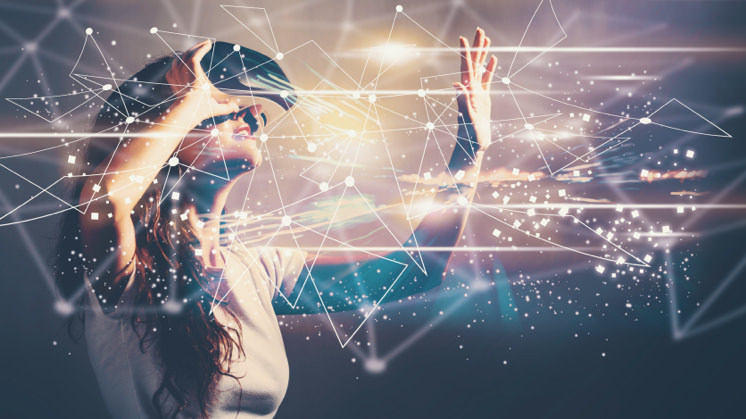Virtual Reality, the technology of the future
Virtual Reality: another world within sight
When we talk about Virtual Reality (VR), many of us think of science fiction films like 'Minority Report'. However, the truth is that nowadays, this technology completely blends in with our daily lives. Video games, medicine, education... Virtual Reality is here to stay. But what is it exactly?

What is Virtual Reality?
Virtual Reality (VR) is a computer-generated environment with scenes and objects that appear to be real, making the user feel they are immersed in their surroundings. This environment is perceived through a device known as a Virtual Reality headset or helmet. VR allows us to immerse ourselves in video games as if we were one of the characters, learn how to perform heart surgery or improve the quality of sports training to maximise performance.
Although this may seem extremely futuristic, its origins are not as recent as we might think. In fact, many people consider that one of the first Virtual Reality devices was called Sensorama, a machine with a built-in seat that played 3D movies, gave off odours and generated vibrations to make the experience as vivid as possible. The invention dates back as far as the mid-1950s. Subsequent technological and software developments over the following years brought with them a progressive evolution both in devices and in interface design.
Differences with Augmented Reality
Despite being a technology that originated decades ago, many people are still unfamiliar with the concept of Virtual Reality. It is also quite common to confuse the term Virtual Reality with augmented reality.
The main difference between the two is that VR builds the world in which we immerse ourselves through a specific headset. It is fully immersive and everything we see is part of an environment artificially constructed through images, sounds, etc. On the other hand, in augmented reality (AR), our own world becomes the framework within which objects, images or similar are placed. Everything we see is in a real environment and it may not be strictly necessary to wear a headset. The clearest and most mainstream example of this concept is Pokémon Go.
However, there is also a combination of both realities called mixed reality. This hybrid technology makes it possible, for example, to see virtual objects in the real world and build an experience in which the physical and the digital are practically indistinguishable.
Main applications of Virtual Reality
That's enough about the theory that is projecting us into the future. Which sectors is Virtual Reality actually being used in today? Medicine, culture, education and architecture are some of the areas that have already taken advantage of this technology. From guided museum visits to the dissection of a muscle, VR allows us to cross boundaries that would otherwise be unimaginable.
INNOVATIVE USES FOR VIRTUAL REALITY
Dining
Now we can travel virtually to different places and immerse ourselves in certain environments while tasting the dishes from these locations.
Medicine
The Spanish National Research Council has succeeded in reducing the effects of Parkinson's in several patients by applying a treatment that uses VR.
The media
Immersive journalism takes the user to the places where events have occurred with live streaming of 360° videos.
Education
In classrooms, the use of VR allows students to better retain knowledge and helps students with learning difficulties.
Entertainment
Users can enter a scene in a video game or practice extreme sports without moving from their sofa.
Architecture
RV helps architects to better envisage a space and present the project to their clients.
Industry
Digital Twins are exact digital copies of physical objects that factory workers can practice on and test in a virtual world.
Culture / Art
Some museums and galleries offer virtual visits or immersive experiences to help understand the history and culture associated with each work.
Military
The UK Ministry of Defence uses VR for training in simulated combat environments.
The future of Virtual Reality
Virtual Reality is one of the technologies with the highest projected potential for growth. According to the latest forecasts from IDC Research (2018), investment in VR and AR will multiply 21-fold over the next four years, reaching 15.5 billion euros by 2022. In addition, both technologies will be key to companies' digital transformation plans and their spending in this area will exceed that of the consumer sector by 2019. It is, therefore expected that by 2020 over half of the larger European companies will have a VR and RA strategy.
Nowadays, the market is demanding applications that go beyond leisure, tourism or marketing and are more affordable for users. Virtual interfaces also need to be improved to avoid defects such as clipping, which makes certain solid objects appear as though they can be passed through. Or to minimise the effects that VR produces in people, among them motion sickness, which consists of a dizziness induced by the mismatch between the movement of our body and what is being seen in the virtual world.
The big technology companies are already working to develop headsets that do not need cables and that allow images to be seen in HD. They are developing Virtual Reality headsets in 8K and with much more powerful processors. There is even talk that in the next few years they could integrate Artificial Intelligence. The latest 5G standard can also provide very interesting scenarios for the evolution of VR. This standard will allow more devices and large user communities to be connected. In addition, its almost imperceptible latency will make it possible for consumers to receive images in real time, almost as if they were seeing them with their own eyes.
All this means that Virtual Reality is no longer science fiction. It is integrated into our present and, in the coming years, it will lead to advances that will shape the future.




